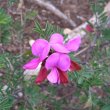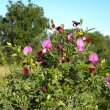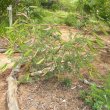| Botanical Name |
|
| Family |
Fabaceae - The legume and pod-bearing family. (Pea & Bean Family) |
| Pronunciation |
tef-ROH-see-uh gran-dih-FLOR-uh |
| Common Name(s) |
IsiZulu: Ihlozane; Iqwense; Udabane
|
| Plant Group |
- Shrub A woody plant of relatively low height, having several stems arising from the base and lacking a single trunk; a bush.
- Veld Flower Small veld flowers of interest, rather than for their usefulness in the garden. Some of these plants have garden potential, particularly for less formal garden situations.
|
| Plant Size |
- Small to Medium
| Tree | 8m to 15m |
| Shrub | 75cm to 1m |
| Perennial/ground cover | 20cm to 40cm |
| Bulb | 30cm to 40cm |
| Succulent | 20cm to 40cm |
|
| Position |
- Light or Dappled Shade Found below trees with sparse, open foliage. Ideal for the protection of herbaceous plants.
- Partial Shade The area is in shade for part of the day and in full sun for part of the day.
- Sun The area is in full sun for all or most of the day, all year round.
|
| General Information |
- Drought Tolerance: Moderate The plant is moderately adapted to arid conditions and can survive short periods of drought and high temperatures without extra water.
- Evergreen to semi-deciduous The plant is evergreen in warmer, wetter parts of the country, but may lose some of its leaves during winter in colder, drier situations.
- Frost: Tender A plant that will not survive any frost or low winter temperatures.
- Water Moderate These plants will need some extra watering compared to water-wise plants. Plant them together, in at least some shade and in a convenient proximity to the house so that grey water can be utilised during times of drought.
- Wind Tolerant Plants able to withstand the effect of strong winds.
|
| Specific Information |
Tephrosia grandiflora is a small, somewhat sparse, erect shrub with long, slender stems which become woody with age. The feathery, compound leaves consist narrow, dark green leaflets against which the bright buds and flowers make a dramatic contrast. The whole plant is slightly hairy, but more so on the younger growth. This is not a long-lived plant, lasting only a couple of years before it becomes woody and sparse. It is semi-deciduous during drought years but remains evergreen when rain has been more plentiful. Flowering occurs throughout the year with a flush in spring. Fruits are long, narrow pods, carrying many seeds which burst open, scattering them quite a distance from the mother plant. The germination rate of seeds in a garden situation is a great deal higher than that of plants in the veld.
|
| Ad Break |
|
| Flowers |
| Description |
large pea flower with one or a few blooms at the ends of branches
|
| Season |
- All Year Plants will seldom bloom for the entire season as given in the list, but should flower during a period within these parameters.
- Summer to Autumn Plants will seldom bloom for the entire season as given in the list, but should flower during a period within these parameters.
|
| Colour |
|
| Growth Rate |
- Fast Specifying growth rate can be very misleading as there is considerable variation of growth rate depending on type and species of plant, available water, supplementary feeding, mulching and general care, as well as the plants suitability and adaptability to the garden environment.
|
| Plant Uses |
- Attracts bees, butterflies or other insects This plant attracts insects which can be food for birds or other creatures in your garden.
- Border A strip of ground, at the edge of a driveway or path in which ornamental plants or shrubs are planted.
- Filler Either a fast growing tree or shrub used temporarily to fill in an area while the permanent plants grow to a desired size, or a plant used to fill gaps in borders or beds.
- Suitable for coastal gardens Plants adapted to dry, sandy soil, forceful wind, limited rainfall and intense sunlight.
- Wild Garden An indigenous garden planted for the benefit of wildlife and birds. Provides food, water, a variety of mini-biomes and no poisonous chemicals are used.
|
| Distribution and Habitat |
in the Eastern Cape Province around Bathurst and East London and in the KwaZulu-Natal midlands and along the coast, in grasslands, along road sides and in damp places
|
| Planting Suggestions |
Plant Tephrosia grandiflora in sun or light shade in well drained soil. A little compost and a layer of mulch can be added. Water moderately. Rich soil and too much moisture will result in more leafy growth and fewer flowers. To prevent an invasion of seedlings, cut off the seed pods before they release their seeds. The plant tolerates a little trimming and pinching back but always remains thinly branched.
|
| Medicinal Uses |
|
| Ad Break |
|










Discuss this plant
Share knowledge, ask a question or give an experience.